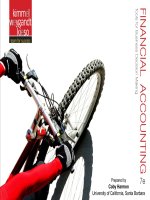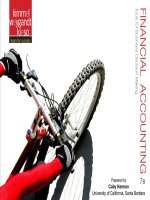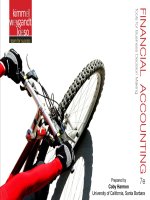Financial accounting tools for business decision making 9 KIeso ppt app h
Bạn đang xem bản rút gọn của tài liệu. Xem và tải ngay bản đầy đủ của tài liệu tại đây (148.45 KB, 45 trang )
Financial Accounting: Tools for Business Decision Making
Ninth Edition
Kimmel ● Weygandt ● Kieso
Appendix H
Reporting and Analyzing Investments
Prepared by
COBY HARMON
This slide deck contains animations. Please disable animations if they cause issues with your device.
University of California, Santa Barbara
Westmont College
Chapter Outline:
Learning Objectives
LO 1
Explain how to account for debt investments.
LO 2 Explain how to account for stock investments.
LO 3
Discuss how debt and stock investments are reported in the financial statements.
Copyright ©2019 John Wiley & Sons, Inc.
2
Learning Objective 1
Explain How to Account for Debt Investments
LO1
Copyright ©2019 John Wiley & Sons, Inc.
3
Reasons Corporations Invest
Corporations purchase investments in debt or stock securities generally for one of three
reasons
1.
2.
3.
Corporation may have excess cash
Generate earnings from investment income
For strategic reasons
Invest
Cash
Temporary Investments
Sell
Accounts
Inventory
Receivable
LO1
Copyright ©2019 John Wiley & Sons, Inc.
4
Why Corporations Invest (1 of 2)
Review Question
Pension funds and banks regularly invest in debt and stock securities to:
LO1
a.
house excess cash until needed.
b.
generate earnings.
c.
meet strategic goals.
d.
avoid a takeover by disgruntled investors.
Copyright ©2019 John Wiley & Sons, Inc.
5
Why Corporations Invest (2 of 2)
Review Question
Pension funds and banks regularly invest in debt and stock securities to:
LO1
a.
house excess cash until needed.
b.
generate earnings.
c.
meet strategic goals.
d.
avoid a takeover by disgruntled investors.
Copyright ©2019 John Wiley & Sons, Inc.
6
Accounting for Debt Investments
•
Consist of investments in government and corporation bonds
•
Entries are made to record
LO1
•
the acquisition
•
the interest revenue, and
•
the sale
Copyright ©2019 John Wiley & Sons, Inc.
7
Recording the Acquisition of Bonds
•
Cost includes all expenditures necessary to acquire these investments
•
Such as the price paid plus brokerage fees (commissions)
Illustration: Kuhl Corporation acquires 50 Doan Inc. 8%, 10-year, $1,000 bonds on January 1, 2022,
for $50,000.
Entry to record the investment
Debt Investments (50 ì $1,000)
Jan. 1
LO1
50,000
Cash
50,000
Copyright â2019 John Wiley & Sons, Inc.
8
Recording Bond Interest (1 of 3)
Recording Bond Interest
Calculate and record interest revenue based upon the
LO1
•
carrying value of the bond
•
times the interest rate
•
times the portion of the year the bond is outstanding
Copyright ©2019 John Wiley & Sons, Inc.
9
Recording Bond Interest (2 of 3)
Kuhl Corporation acquires 50 Doan Inc. 8%, 10-year, $1,000 bonds on January 1, 2022, for $50,000.
The bonds pay interest annually on January 1. If Kuhl Corporation’s fiscal year ends on December
31, prepare the entry to accrue interest earned by December 31.
Bond Interest = $50,000 × 8% = $4,000
Interest Receivable
Dec. 31
LO1
Interest Revenue
Copyright ©2019 John Wiley & Sons, Inc.
4,000
4,000
10
Recording Bond Interest (3 of 3)
•
At December 31
•
Interest Receivable reported as a current asset in the balance sheet
•
Interest Revenue reported under “Other revenues and gains” in the income statement
Entry for receipt of the interest on January 1 of the following year
Cash
Jan. 1
LO1
Interest Receivable
Copyright ©2019 John Wiley & Sons, Inc.
4,000
4,000
11
Recording Sale of Bond Investments (1 of 2)
LO1
•
Credit investment account for cost of bonds
•
Record as a gain or loss any difference between
•
Net proceeds from sale (sales price less brokerage fees), and
ã
Cost of bonds
Copyright â2019 John Wiley & Sons, Inc.
12
Recording Sale of Bond Investments (2 of 2)
Assume that Kuhl corporation receives net proceeds of $53,000 on the sale of the Doan Inc. bonds
on January 1, 2023, after receiving the interest due. Prepare the entry to record the sale of the
bonds.
Cash
Jan. 1
Debt Investments
LO1
Gain on Sale of Debt Investments
Copyright ©2019 John Wiley & Sons, Inc.
53,000
50,000
3,000
13
Accounting for Debt Investments (1 of 4)
Review Question
An event related to an investment in debt securities that does not require a journal entry is:
LO1
a.
acquisition of the debt investment.
b.
receipt of interest revenue from the debt investment.
c.
a change in the name of the firm issuing the debt securities.
d.
sale of the debt investment.
Copyright ©2019 John Wiley & Sons, Inc.
14
Accounting for Debt Investments (2 of 4)
Review Question
An event related to an investment in debt securities that does not require a journal entry is:
LO1
a.
acquisition of the debt investment.
b.
receipt of interest revenue from the debt investment.
c.
a change in the name of the firm issuing the debt securities.
d.
sale of the debt investment.
Copyright ©2019 John Wiley & Sons, Inc.
15
Accounting for Debt Investments (3 of 4)
Review Question
When bonds are sold, the gain or loss on sale is the difference between the:
a. sales price and the cost of the bonds.
b. net proceeds and the cost of the bonds.
c. sales price and the market value of the bonds.
d. net proceeds and the market value of the bonds.
LO1
Copyright ©2019 John Wiley & Sons, Inc.
16
Accounting for Debt Investments (4 of 4)
Review Question
When bonds are sold, the gain or loss on sale is the difference between the:
a. sales price and the cost of the bonds.
b. net proceeds and the cost of the bonds.
c. sales price and the market value of the bonds.
d. net proceeds and the market value of the bonds.
LO1
Copyright ©2019 John Wiley & Sons, Inc.
17
Learning Objective 2
Explain How to Account for Stock Investments
LO2
Copyright ©2019 John Wiley & Sons, Inc.
18
Accounting for Stock Investments
Ownership
Ownership Percentages
Percentages
0 --------------------20% ----------------- 50% ----------------------- 100%
No significant influence
Significant influence
usually exists
usually exists
Investment valued using
Investment valued using
Cost Method
Equity Method
Control usually exists (50%+ owned)
Investment valued on parent’s books using Cost
Method or Equity Method (investment
eliminated in Consolidation)
The accounting depends on the extent of the investor’s influence over the operating and financial affairs of the issuing corporation
(investee).
LO2
Copyright ©2019 John Wiley & Sons, Inc.
19
Stock Investments – Less than 20% (1 of 3)
•
Companies use the cost method
•
Investment is recorded at cost and revenue recognized only when cash dividends are
received
•
Cost includes all expenditures necessary to acquire these investments, such as price paid
plus any brokerage fees (commissions), if any
LO2
Copyright ©2019 John Wiley & Sons, Inc.
20
Stock Investments Less Than 20% (1 of 3)
Recording Acquisition of Stock
Illustration: On July 1, 2022, Sanchez Corporation acquires 1,000 shares (10% ownership) of Beal
Corporation common stock. Sanchez pays $40 per share.
Entry for the purchase
Stock Investments ($40 ì 1,000)
Jul. 1
LO2
40,000
Cash
40,000
Copyright â2019 John Wiley & Sons, Inc.
21
Stock Investments Less Than 20% (2 of 3)
Recording Dividends
Illustration: During the time Sanchez owns the stock it makes entries for any cash dividends
received. Sanchez receives a $2 per share dividend on December 31.
Entry for receipt of dividends
Cash (1,000 × $2)
Dec. 31
LO2
Dividend Revenue
Copyright ©2019 John Wiley & Sons, Inc.
2,000
2,000
22
Stock Investments Less Than 20% (3 of 3)
Recording Sale of Stock
Illustration: Assume that Sanchez Corporation receives net proceeds of $39,500 on the sale of its
Beal stock on February 10, 2023. Because the stock cost $40,000, Sanchez incurred a loss of $500.
Entry to record the sale on February 10
Cash
Feb. 10
Loss on Sale of Stock Investments
LO2
Stock Investments
Copyright ©2019 John Wiley & Sons, Inc.
39,500
500
40,000
23
Stock Investments 20% to 50% (1 of 4)
Equity Method
a.
Investor records the investment at cost and subsequently adjust the amount each period
for the
proportionate share of earnings (losses)
dividends received
If investor’s share of investee’s losses exceeds the carrying amount of the investment, the investor
ordinarily should discontinue applying the equity method
LO2
Copyright ©2019 John Wiley & Sons, Inc.
24
Stock Investments 20% to 50% (2 of 4)
Illustration: Milar Corporation acquires 30% of the common shares of Beck Company for $120,000 on January 1,
2022. For 2022, Beck reports net income of $100,000 and paid dividends of $40,000.
Entry to record purchase
Stock Investments
Jan. 1
120,000
Cash
120,000
Entry to record share of net income
Dec. 31 Stock Investments ($100,000 ì 30%)
LO2
Revenue from Stock Investments
Copyright â2019 John Wiley & Sons, Inc.
30,000
30,000
25









